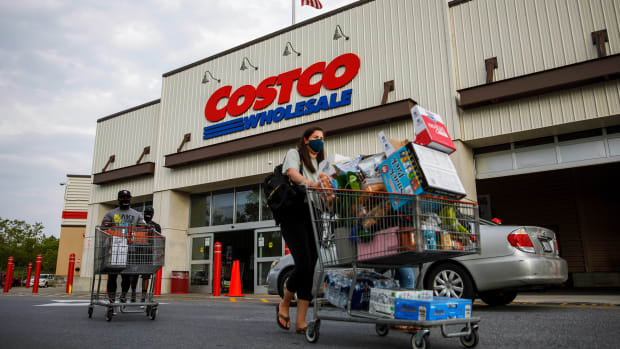Consumers think about prices when they go up, but they're not very good at recognizing exactly what's happening.
That's especially true when it comes to groceries. People believe that prices have gone up by 22.8% while they have actually risen by 13.1%.
That's still a big increase, of course, but in many ways perception matters more than reality. If shoppers think prices are skyrocketing, they appreciate value more. Rising prices have benefited retailers that traditionally offer customers good value.
Target (TGT) and Walmart (WMT) sit at the top of that list, and both have talked about not fully passing on higher prices to customers. In addition, both of those retailers can afford to use groceries as a low-margin way to attract customers to their stores in order to get them to buy other things.
That's an advantage over a pure-play grocery company like Kroger (KR), which needs to actually make money with its core product line.
Costco (COST), which competes with Walmart, Target, and Kroger, actually has an advantage over its rivals. That's something that should benefit the warehouse club in both perception and reality.

Ting Shen/Xinhua via Getty
Costco's Weakness Is Its Strength
Costco stocks about 4,000 products while a typical grocery store keeps 25,000 to 50,000 on its shelves. That means Walmart and Target shoppers have more selection but Costco has certain advantages as well, according to Chief Financial Officer Richard Galanti's comments during the warehouse club's fourth-quarter-earnings call.
"I think again, we're in as good a position, if not better, than anybody, given that our buying power per item is off-the-charts high compared to anybody else and our buyers' focus on the detailed components of it," he said.
Galanti made clear that while some factors that have driven prices higher -- like higher employee wages -- aren't easing, Costco has leverage other companies don't when it comes to making better deals with vendors. That won't always work, but the CFO is confident that its limited product selection will work in the chain's favor.
"I think, again, we're in the best position when you think about we've got lots of $50 million and $100 million and $200 million and even higher items and even a handful of billion-dollar SKUs," he said. (SKUs refers to individual products.)
"So we think we are pretty good at figuring that out with our suppliers, not only just to say, hey, the price went down on this commodity or this supply cost component, but also on figuring out how to make things more efficient."
Costco Works With Vendors to Lower Costs
Because Costco stocks fewer items, but buys what it does sell in such big numbers it can really put the screws to its vendors.
"There are things that I hear at the budget meetings all the time about how on $100 million, $200 million, $500 million SKUs, how they're taking costs. So which right now meant that the price increase was lower than it would have been. But now they took cost out by changing the production line or eliminating some of the inside packaging. And that's part of ESG, as well as figuring out how to lower the cost," he said,
It's all about leveraging the company's buying power to get vendors to make changes like the ones listed above.
"And again, I don't know if anybody does it as well as we do, given that we're focused on such bigger volumes of an item," Galanti added.
The CFO also made clear that Costco improves its bottom line by driving volume, not by raising prices to "harvest" extra margin.
"If we can incrementally get another percentage point of [comparable] sales, that does more than any kind of harvesting we would ever want to do, which we don't do," he added.







